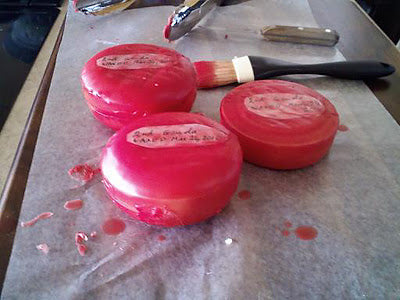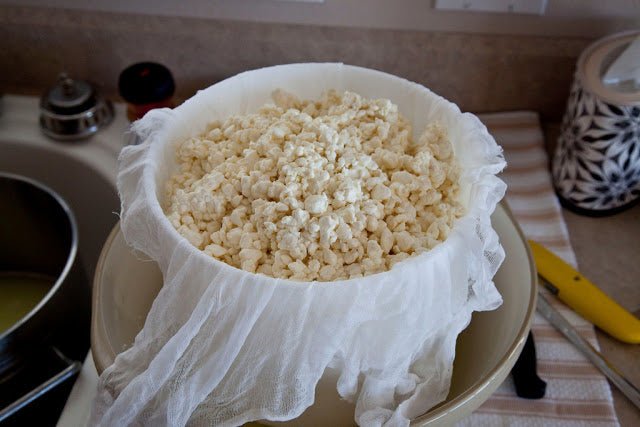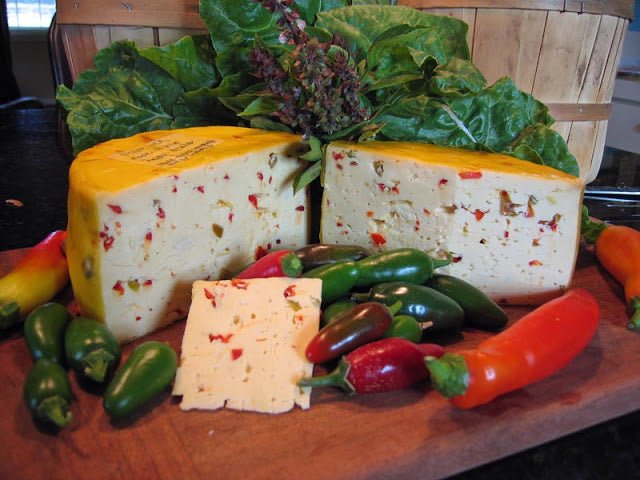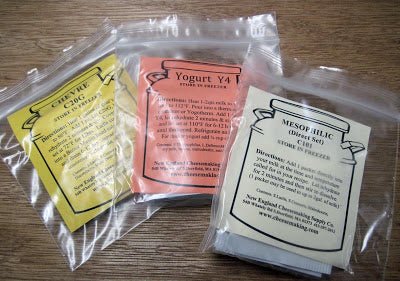I went to wax a 1.5 lb Parmesan wheel and didn’t have a good enough grip on it. I ended up dropping it in the wax with the wax splashing out of the pot onto the counter, stove and floor. It was everywhere.
I spent 5 hrs that night and 3 the next day trying my best to clean it up. Wax is unbelievably hard to clean up, I found out. A good thing my wife was out of town at the time. Now my wife leaves the house when I make cheese. I wonder why.
 |
| First Gouda cheese made from Ricki’s kit. It was delicious. Harder than store-bought. We liked it better. |
A friend of mine from the west coast sent me Ricki’s cheese kit for both soft and hard cheeses last summer (Thanks Kim). She did not know that I was interested in cheese, but for some reason she thought I might like it. At the time, she was making soft cheeses like Ricotta.
I became interested in cheeses, when through my job and my relocations I was in places that had a great variety of good cheese. My wife and I would try all types of different cheeses at the markets and then bring them home for eating with wine, bread, crackers, fruit or use in cooking. We became fond of a large variety of cheeses including sheep and goat.
Over time I have added more molds and equipment. I am having a great time. So far, I have 1.5lbs Parmesan, 4 (0.75lbs) Baby Gouda, 3.5 lb Gouda wheel and 3.5 lb Colby in the cheese cave (a wine cooler). Some success was 4 previous Baby Gouda (although the one pressed with more weight was better), a delicious 3.5 lb Gouda wheel, and a first time Feta that is great on salad. This week, the Crème Fraiche turned into Mascarpone was unbelievably gourmet good on fresh berries.
 |
| Second try at Gouda with baby molds-on their way to the cave. |
What are you using for milk?
 |
| First press (modified twice since). My design was a little lopsided. |
What are you using for a press?
I made my own press. I researched on the internet and had my own ideas (naïve as they were) about what would work. Went to Lowes and bought material and put it together. The press was a direct weight press. I just added weight to the stem, which pressed the cheese. It actually worked pretty well. Although, if doing it again some things would change.
Where do you age your cheese?
I age the cheese in a wine cooler that I bought-one that had temperature controls. I set it at 54F and it keeps a temperature of 54-55 constantly. The humidity is very dry here and the cooler does not have any automatic humidity controls, so I have been watching with a humidistat. I think the wet cheese drying keeps the humidity around 80%. The cooler seems to work great for me. I just put it in a storage room away from home activity. The cheese seems to be happy.
Any tips for others starting out?
Because of (the wax incident), my Parmesan did not get a good seal from the wax and mold began to grow under it. I cut it off the other day and brined the cheese. We’ll see in a couple of months whether it actually turns out. I have gone to developing natural rinds instead of waxing. Although it takes some care, at least weekly, by wiping them down with brine and putting olive oil on them, I think they look better and in the end for me, it is less work. That doesn’t mean I won’t do waxing in the future, but if I do I will be more careful.
The other learning is when increasing recipes. Doubling or tripling the recipe is very doable by proportionately increasing the ingredients. But, if this means using larger molds, then you have to add more weight. I realize that a lot of home cheese makers make small batches. But, if one makes a larger batch and uses a larger mold then more weight is important.
 |
| Second Gouda after waxing. They were dipped and then filled in spots with brush |
Did you make cheese this week?
Another Hobby
Larry is also an accomplished nature photographer. You can see some of his work (mostly birds) on www.lltphoto.com.
Question and Answer Regarding Pressing Cheese
Q. (From Larry) I have been seeing in the www.cheeseforum.org that the amount of pressure for pressing cheese should be figured on a PSI basis and not straight pounds. This is because the batches vary from small to large and the area of the molds vary. So I may not be putting enough weight onto the cheese – mainly for the final press, I think. For instance, if I press gouda in my large Tome mold at the recipe weights the PSI is about 1. The some on the forums (commercial folks) say they press at 3.5 to 5. The Parma in the Rikki’s recipe book is more like 20 lbs. where the Parma recipe on the WEB site is 85-125 lbs.
I am wondering if there is or if you have a table of PSI for different cheeses. I realize the duration of aging (short period vs long period) requires different pressing weights, but thought there might be some general rules to guide a person. Or maybe I should increase the weight in the recipe proportionately to the gallons of milk used? Do you have any information on this subject or PSI?
A. (From Jim Wallace) Larry, Ricki wrote her book to address the issues of the home cheese maker. “PSI” is a foreign concept to these folks so Ricki decided to standardize and simplify the entire process. She focuses on the small mold we sell and designed these small packs of culture to work for the home cheese maker in a manageable 2 gallon batch. Therefore it is simply a matter of suggesting a weight mass for each cheese in the book.
Now if you are working with larger molds then it is simply a matter of comparing relative surface areas and adjusting weights proportionately.
Surface area = (radius of surface squared x 3.1416
our small mold (M3) used for Ricki’s book is 4.5 inch diameter and surface area is about 16 sq in
our larger mold (M2) is 7.74 inch diameter with surface are of about 47 sq in.
therefore switching from the small mold to larger mold the weight needs to be increased by 47/16 or 2.9 times so a 20 lb weight for the larger mold would need to be 58 lbs.
HOWEVER: these are just guidelines and the real pressing, whether you use weight or lbs per sq in, depends on the final moisture and aging potential of your cheese.
NOTE: be very careful when reading pressure as “PSI” because quite often it is not the surface “PSI” but that read on a gauge in a hydraulic system where the diameter of the pressure plate and that of the piston are of different diameters but that is another story.







































































































































































